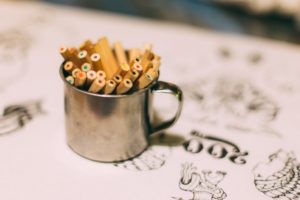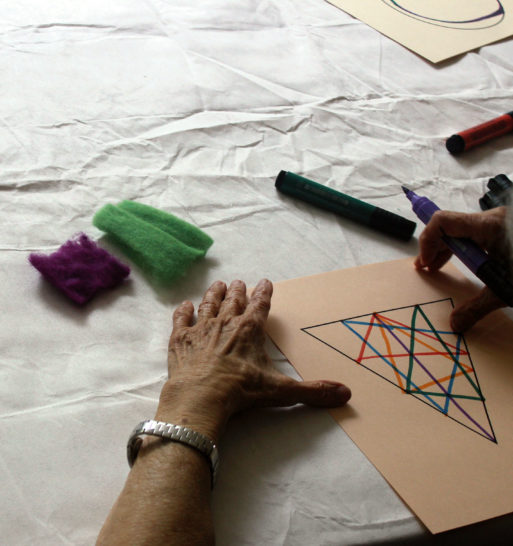
Credit: Kirk Waller
Welcome back to Part Two of SevenPond’s interview with Sadie Harmon. Sadie creates new ways to use art to communicate with and carry out the wishes of people with dementia who are living at home and active in their communities. Last August she joined Elder Care Alliance, a network of five senior living communities in California’s Bay Area. Programs she has been piloting extend ECA’s dementia support system beyond its five special care facilities into San Francisco neighborhoods. The innovative work, funded by the San Francisco Foundation, centers on improving the quality of life for people with dementia by giving them greater access to arts and culture.
Editor’s Note: This interview has been edited for length and readability.
Laura B. Hayden: How did you get started working with the older population?
Sadie Harmon: I actually started volunteering in a skilled nursing facility when I was 14 and continued through high school.
Laura: That’s a challenging community for a high school student.
Sadie: I had always been around a lot of elder adults growing up. I had really close relationships with my grandmothers. When I left college, I realized that all of my friendships were with people in my peer group. I missed having older people in my life so I started volunteering at assisted living communities in Chicago for about four years. Then I moved to California for my graduate art degree.
In graduate school, I participated in critique groups with peers and people who were coming from art museum backgrounds. I wanted to get some other feedback, which led me to start conducting an open studio in an assisted-living community. Once a week I’d bring whatever I was working on in a suitcase.
Laura: Did the residents just watch?
Sadie: It started with just me working but ended up with us having kind of a little quilting circle. People would come and talk to me. Some would bring their own work. So then I started to bring extra material and just have it out.
 Laura: Were you following some sort of model for this?
Laura: Were you following some sort of model for this?
Sadie: Oh no. I thought of it.
Laura: You did! I’m very impressed that this was initially your idea.
Sadie. Yes — and that was when it clicked for me. This is something that exists. There are people whose careers focus on creating art programs for older adults that consider aging and end of life. So I left that community and went to work for a nonprofit that supported creative aging programs.
Laura: I can see how this reconnected you to the elder community you always had an affinity for. How did these interactions differ from those you had with your older family members?
Sadie: Working full time in memory care, I began to see how much of a stigma there is associated with people living with dementia. There’s even a lot of fear of memory care among residents of assisted living communities. But when I was with those living with dementia, I found there were all these incredible people who had really incredible stories. I’ve come to realize many of them are living alone and don’t know about community services that can help them socialize and add some high-quality experiences to their day through reconnecting with art.
Laura: Can you explain how a workshop in the community might look?
Sadie: Well, yesterday was pretty interesting. I brought my suitcase full of art supplies to a social day program in San Francisco. There I met another artist I’ve been collaborating with, Lola Fraknoi. We’ve been experimenting with setting up workspaces in different ways.
First, we cleared everything that might be a distraction out of a small room and covered the tables with white paper. It’s important that our participants work in a clean, organized environment — like a real artist’s studio.
That done, we began by giving six clients an open-ended prompt and just one colored pencil (so as not to overwhelm anyone) — and then gave them options beyond. that. For the next hour, I felt like I was meditating. It was incredible. Me, Lola, and six participants — at one point the room was completely silent except for the sound of pencils moving!

Artist at work at Sadie’s workshop last week.
Credit: Sadie Harmon
Laura: Does it matter what they produced?
Sadie: It does and it doesn’t. One of my rules is that there is no right or wrong, and one of the great things about art is that you have to fail to make good art. Nothing comes out perfect the first time. So there is already the process within the art that gives permission to explore and play. What does matter is that people always feel proud when they make something.
Laura: What did you do as time passed?
Sadie: This week I observed behaviors while Lola facilitated. She let them work, keeping an eye out for who wanted another color. If someone was done she asked them about their work in much the same way that art is critiqued in art school. Not by just saying, “That’s pretty,” but by giving positive feedback like, “That line is really interesting. I like how it connects to that image.”
Laura: Did the participants talk to each other?
Sadie: Yes they did, and that’s part of the goal. Research tends to suggest that art-making has a positive effect on people feeling a social connection. Some studies are also looking into how art affects behavior and moods. Can it be used as a sedative instead of drugs? In the big picture, this program really looks at what kind of culture changes can assist people living with dementia and their caretakers. How do we empower people to become self-advocates? Art can help. Next week we’ll work more with color.
Laura: Thank you for sharing your experience of making art accessible to people who are living with dementia, Sadie. It’s been an enlightening conversation.
If you missed Part One of our interview the Sadie Harmon please catch up here.

 How Can Art Serve Dementia-Inclusive Communities?
How Can Art Serve Dementia-Inclusive Communities?


 First the Wealth Gap, Now the U.S. Has a Growing Health Gap
First the Wealth Gap, Now the U.S. Has a Growing Health Gap

 Our Annual Seven Holiday Gifts for Someone Who Is Grieving, 2024 Edition
Our Annual Seven Holiday Gifts for Someone Who Is Grieving, 2024 Edition














